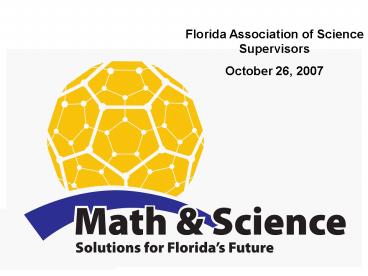Florida Association of Science Supervisors - PowerPoint PPT Presentation
1 / 15
Title:
Florida Association of Science Supervisors
Description:
... governing safe storage of laboratory chemicals, equipment, and supplies. ... Offers recommendations for enhancing lab safety conditions and practices in the ... – PowerPoint PPT presentation
Number of Views:28
Avg rating:3.0/5.0
Title: Florida Association of Science Supervisors
1
Florida Association of Science Supervisors October
26, 2007
2
What are school science lab investigations good
for?
- enhancing mastery of subject matter
- developing scientific reasoning
- understanding the complexity and ambiguity of
empirical work - developing practical skills
- understanding the nature of science
- cultivating interest in science and interest in
learning science and - developing teamwork abilities.
- America's Lab Report Investigations in
High School Science (2005)
3
A Study of lab injury data in Iowa revealed that
- The number of claims rose from 674 in
1990-1993 to 1,002 in 1993-1996, - and the cost to insurance companies rose
from 1.68 to 2.3 million. - the number of law-suits grew from 96 to
245, and awards in these suits grew from
566,305 to 1.2 million -
-
(Gerlovich et al., 2002)
4
- Maintaining student safety during laboratory
experiences is a critical concern, but little
systematic information is available about safety
problems and solutions. - America's Lab Report Investigations in High
School Science (2005)
5
The Council of Chief State Science Supervisors
(CCSSS) has defined three essential lab safety
duties of every classroom science teacher
- The duty of instruction.
- The duty of supervision.
- The duty of maintenance.
6
Duty of Instruction
- Teachers must instruct students prior to any
laboratory activity, - providing accurate, appropriate information
about foreseeable dangers - identifying and clarifying any specific
risks - explaining proper procedures/techniques
- and describing appropriate behavior in the
lab. These instructions must follow
professional and district guidelines.
7
Duty of Supervision.
- not tolerating misbehavior,
- providing greater supervision in more
dangerous situations, - providing greater supervision to younger
students and those with special needs, - and never leaving students unattended.
8
Duty of Maintenance
- never use defective equipment,
- file written reports for maintenance or
correction of hazardous conditions or defective
equipment, - establish regular inspections of safety
equipment and procedures, - and follow all guidelines for handling and
disposing of chemicals.
9
What are Standards of Care?
- The Building Officials and Code Administrators
International, Inc., and the National Fire
Protection Association, Inc. establish guidelines
for class and lab size. The current standards
call for 50 sq.ft. of workspace per student. - OSHA established the Laboratory Standard (29 CFR
1910.1450), which requires school science
teachers to create and maintain a chemical
hygiene plan (CHP). The CHP requires proper
labeling of all chemicals, using a Material
Safety Data Sheet, which outlines important
safety information, and safe storage.
10
The U.S. Environmental Protection Agency (EPA)
administers
- (1) the Resource Conservation and Recovery
Act, - (2) the Emergency Planning and Right-to-Know
laws and regulations, and - (3) the Toxic Substances Control Act. To carry
out provisions of the Resource Conservation and
Recovery Act, EPA issues regulations and
guidelines governing safe storage of
laboratory chemicals, equipment, and supplies. - (http//www.epa.gov/iaq/schools/tf
s/teacher.html).
11
In addition to these federal standards of care,
the the American National Standards Institute
(ANSI) has established voluntary standards for
laboratory safety that include
- ANSI Z358.1guidelines for establishing the
correct design, installation, use, and
performance of emergency safety equipment. - ANSI Z87guidelines for protective equipment at
easily accessible locations. - the American National Standards Institute (ANSI)
has established voluntary standards for
laboratory safety that include - ANSI Z358.1guidelines for establishing the
correct design, installation, use, and
performance of emergency safety
equipment. - ANSI Z87guidelines for protective
equipment at easily
accessible locations.
12
How does a classroom teacher keep up with the
myriad guidelines and regulations governing lab
safety?
13
Lab Safety Best Practices Manual
- Floridas teachers need an up to date central
source that - Clearly delineates their responsibilities and
provides guidance through the maze of federal and
state regulations, - Provides clear and specific guidelines for safety
as it pertains to each grade level and content
area, and - Offers recommendations for enhancing lab safety
conditions and practices in the environment
within which they teach.
14
How can FASS help?
- Relate the specific needs of your district,
- share procedures and best practices that have
been effective in your district, and - work within your district to raise the profile of
lab safety throughout the school system.
15
Florida Association of Science Supervisors October
26, 2007































